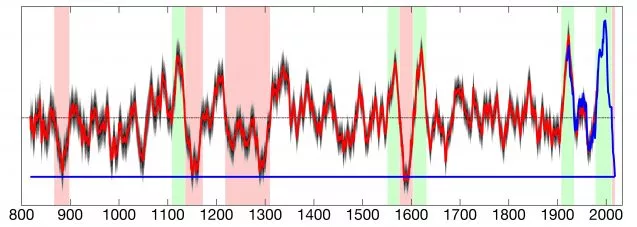The western United States and parts of northern Mexico have been suffering through drought conditions on and off since the year 2000 – and unfortunately it may not let up any time soon. A new study has examined extreme droughts in the region dating back 1,200 years, and found that the current conditions have the makings of a “megadrought” that could last decades.
The study, conducted by researchers at Columbia University, combined data on rainfall and soil moisture from several sources. Modern weather observations date back to around 1900, but tree rings can preserve this information from centuries ago. Generally, trees grow faster during times when water is plentiful, forming wider rings. Conversely, narrow rings indicate periods of drought.
By examining ring data from thousands of trees, the team managed to track drought patterns all the way back to the year 800 CE, in an area encompassing nine US states (Oregon, Idaho, Wyoming, California, Nevada, Utah, Colorado, Arizona and New Mexico) as well as parts of northern Mexico.

Droughts of course are cyclical, and the team spotted dozens of droughts in that 1,200-year period. But among them were four that stood out as megadroughts, with arid conditions lasting decades and in one case, almost a century. These four megadroughts took place in the late 800s, mid-1100s, most of the 1200s, and the late 1500s.
Next, the team compared these large-scale historic events to the one that’s currently unfolding. They took soil moisture records between 2000 and 2018, and compared that 19-year period to the worst 19-year stretches of each of the other droughts. The 21st-century drought, it turns out, ranks worse than the earliest three megadroughts, and about on par with the 16th-century event.
The researchers say that all four previous megadroughts began with patterns similar to what’s happening now, indicating this one might stick around for a while longer yet.
But perhaps the most interesting aspect of the study is the role that climate change is playing. The current drought seems to be affecting a wider area more consistently than the earlier events, which is a hallmark of climate change. In fact, the researchers calculate that this drought would have been pretty moderate otherwise, ranking 11th in severity in the 1,200-year period. Instead, climate change has created higher underlying temperatures which boosted it to the top of the charts.

While there’s always an element of natural variation, the team says that climate change is shifting events like droughts towards the more extreme end of the scale more regularly.
“Because the background is getting warmer, the dice are increasingly loaded toward longer and more severe droughts,” says Park Williams, lead author of the study. “We may get lucky, and natural variability will bring more precipitation for a while. But going forward, we’ll need more and more good luck to break out of drought, and less and less bad luck to go back into drought.”
The research was published in the journal Science.
Source: Columbia University




